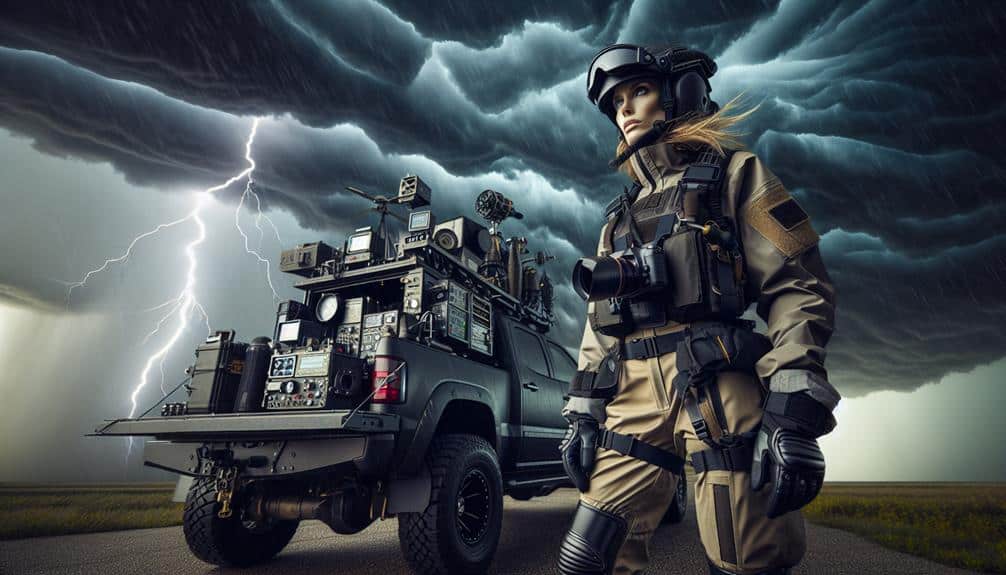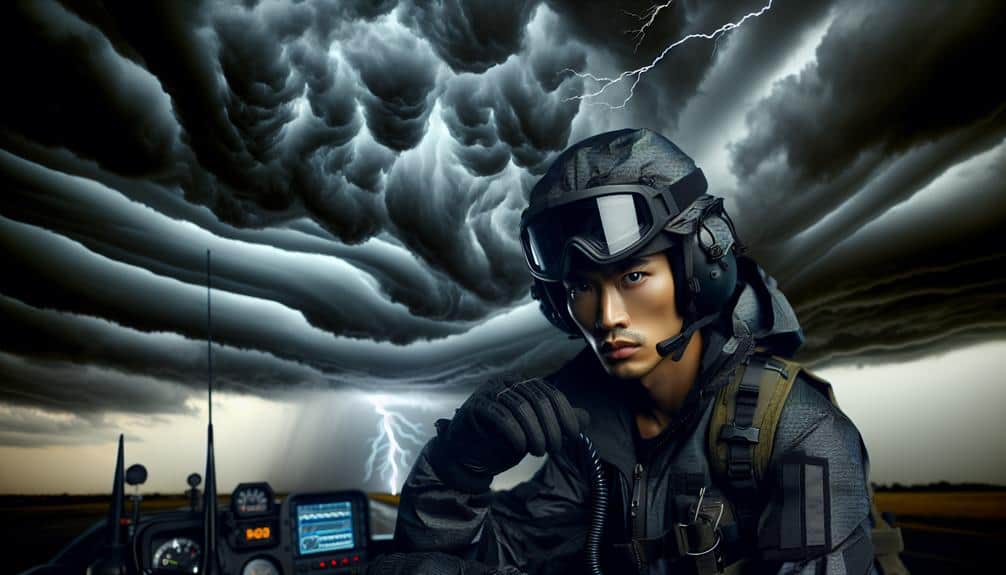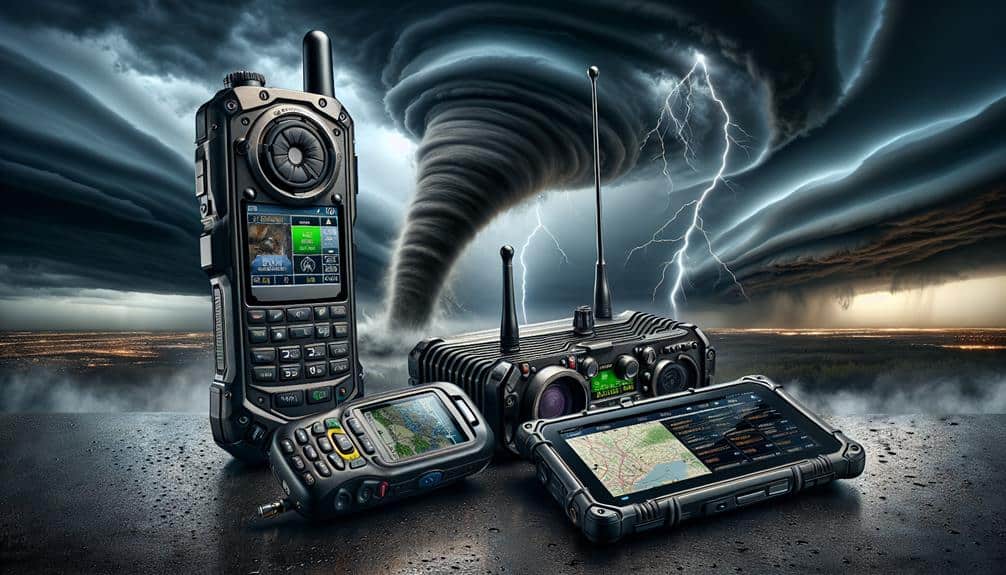To stay safe and succeed in storm chasing, we need high-quality insulated equipment for warmth, protection, and mobility. Essential items include waterproof, wind-resistant insulated jackets, and thermal bottoms. We prioritize gloves and mittens with waterproof durability, wind resistance, and dexterity. Warm hats made from materials like Gore-Tex and fleece guarantee comfort and protection, while insulated footwear with Gore-Tex and advanced traction like Vibram soles provides stability. Layering with moisture-wicking base and mid-layers enhances insulation and temperature regulation, critical during harsh conditions. As we explore further, we'll discover more about specialized insulated gear for storm chasing.
Key Points
- Wear high-quality insulated jackets: They provide warmth, mobility, and protection against wind and water.
- Choose waterproof footwear: Essential for staying dry in rain and muddy conditions, ensuring comfort and durability.
- Use thermal bottoms: For insulation and mobility, keeping your lower body warm and agile during storm chases.
- Opt for insulated gloves and mittens: Waterproof and wind-resistant for maintaining hand warmth and dexterity.
Essential Insulated Jackets
When it comes to storm chasing, having a high-quality insulated jacket is essential for maintaining warmth and mobility in harsh conditions. We need gear that not only keeps us insulated but also guarantees we stay dry and protected against the elements. That's where waterproof outerwear comes into play. It's essential that our jackets repel water effectively, preventing us from getting soaked and risking hypothermia.
Equally important is the use of wind-resistant materials. During a storm, wind gusts can be relentless, and our jackets must provide a shield against these intense forces. By utilizing materials specifically designed to block wind, we can maintain our body heat and focus on the chase without constant discomfort.
Moreover, the jacket's insulation should be lightweight yet efficient. Bulky jackets can restrict our movement, making it harder to navigate through challenging terrains. Instead, we opt for advanced synthetic or down insulation that offers superior warmth without the extra weight.
Thermal Pants and Leggings
Thermal pants and leggings are essential for keeping our lower bodies warm and agile during storm chases. Maneuvering through harsh weather demands clothing that offers both insulation and mobility.
Fleece-lined leggings are an excellent choice, providing a soft, warm layer against our skin. They're perfect for those bone-chilling moments when we need to stay focused and quick on our feet.
Winter thermals, on the other hand, offer a versatile solution for varying conditions. Designed to retain heat while wicking moisture, these thermal bottoms guarantee we stay dry and comfortable. This dual functionality is vital when we're dealing with unpredictable weather patterns and prolonged exposure to the elements.
Windproof tights are another valuable option. Their ability to block gusts of cold wind helps maintain our body temperature, which is crucial when we're out in open fields or on elevated terrains. By creating a barrier against wind chill, these tights keep our muscles from stiffening, allowing us to move freely and react swiftly.
In essence, the right thermal bottoms, whether fleece-lined, windproof, or moisture-wicking, empower us to chase storms with confidence and agility, ensuring we stay warm and prepared for any situation.
Insulated Gloves and Mittens
Insulated gloves and mittens are vital for maintaining dexterity and warmth during our storm-chasing adventures. When we're out in the elements, our hands are often the first to feel the bite of cold and wind. To secure we can operate our equipment and remain comfortable, we need gear that offers both waterproof durability and wind resistance.
Let's break down what to look for in insulated gloves and mittens:
- Waterproof Durability: This feature is essential for keeping our hands dry in wet conditions. Look for materials like GORE-TEX or similar technologies that offer reliable waterproofing without sacrificing breathability.
- Wind Resistance: Gloves and mittens with wind-resistant outer layers help to block the chill, preventing heat loss and maintaining our hand's warmth.
We need to invest in high-quality insulated gloves and mittens to secure our storm-chasing missions are both safe and successful. By prioritizing waterproof durability and wind resistance, we can focus on the thrill of the chase without compromising our comfort and functionality.
Warm Hats and Headgear
When selecting warm hats and headgear for storm chasing, we need to take into account material and insulation, as these dictate how well our heads stay warm.
Proper coverage and fit guarantee that we're fully shielded from the elements without discomfort.
Additionally, breathability and comfort are essential for long hours in changing conditions.
Material and Insulation
Selecting the appropriate material and insulation for warm hats and headgear guarantees we remain protected and comfortable during intense storm chasing adventures. Let's explore the key aspects that define effective headgear.
Firstly, understanding insulation types is essential. Options like synthetic insulation, down, and wool each offer distinct benefits. Synthetic insulation is great for wet conditions due to its quick-drying properties. Down provides superior warmth-to-weight ratios but requires proper care to maintain loft. Wool is naturally water-resistant and retains warmth even when damp.
Materials play a significant role in durability and comfort. High-quality fabrics like Gore-Tex and fleece add layers of protection and maintain longevity. Features such as windproof linings and moisture-wicking capabilities enhance overall performance.
Here are some vital maintenance tips to extend the life of our headgear:
- Care Instructions: Always follow the manufacturer's washing guidelines to avoid damaging insulation.
- Longevity: Store hats in a cool, dry place to prevent mold and material degradation.
Coverage and Fit
Achieving optimal coverage and fit in warm hats and headgear ensures we maximize protection and comfort during storm chasing excursions. Proper sizing is essential to guarantee our headgear stays secure without being overly tight, which could lead to discomfort. We need to measure our head circumference accurately and choose gear that offers sizes fitting our measurements.
Weatherproofing is another important factor; our headgear should repel rain, snow, and wind to keep us dry and warm.
Adjustable features play a noteworthy role in achieving the ideal fit. Look for hats with adjustable straps or drawstrings that allow us to customize the fit according to our preferences. This flexibility is crucial, especially when layering with other gear like hoods or helmets.
Durability is equally significant; our headgear needs to withstand harsh weather conditions and frequent use without deteriorating. High-quality materials and reinforced stitching contribute notably to the longevity of our gear.
Breathability and Comfort
Securing our warm hats and headgear are breathable and comfortable is essential for maintaining focus and endurance during storm chasing. When we're out in the field, we need gear that can handle fluctuating temperatures and varying levels of exertion. Breathability and comfort go hand-in-hand, preventing overheating and moisture buildup that can distract us from our mission.
Key features to take into account include:
- Moisture-wicking fabrics: These materials draw sweat away from our skin, keeping us dry and comfortable even in intense conditions.
- Ventilation options: Adjustable vents or mesh panels allow us to control airflow, ensuring our heads stay cool or warm as needed.
Choosing headgear with these features allows us to operate with freedom and precision. The ability to stay dry through moisture-wicking and regulate temperature with ventilation options can make all the difference in our performance. We should prioritize these elements in our gear selection to make sure we remain clear-headed and focused, no matter what the storm throws at us.
Insulated Footwear Options
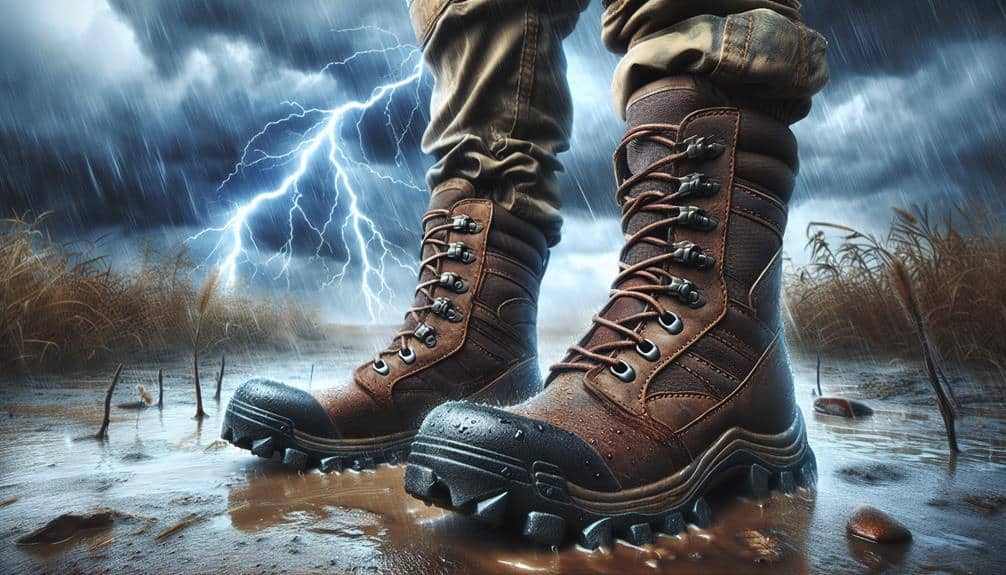
When it comes to insulated footwear options, we need to evaluate durability, warmth, and waterproofing to guarantee our feet stay dry and comfortable during storm chasing expeditions.
First, waterproof options are essential. Our boots must withstand relentless rain and muddy conditions without compromising comfort. Look for materials like Gore-Tex that offer excellent waterproofing while maintaining breathability.
Durability is another important factor. We can't afford to have our boots falling apart in the middle of a chase. High-quality leather or synthetic materials with reinforced stitching will secure longevity. Additionally, boots with rugged outsoles that resist abrasion and punctures will serve us well.
Next, traction control is crucial for our safety. Slipping on wet or uneven terrain can be disastrous. Advanced grip technology, such as Vibram soles, provides superior traction, letting us maintain stability even in the most treacherous conditions. Deep lugs and multi-directional patterns on the outsole will further improve grip, giving us the confidence to navigate varied landscapes.
Lastly, insulation plays an important role in keeping our feet warm. Thinsulate or PrimaLoft insulation can offer excellent warmth without adding bulk, ensuring our feet are cozy and ready for action.
Layering Techniques
When storm chasing, our approach to layering can make a significant difference in comfort and safety.
We'll start by examining the importance of base layers in moisture management and insulation.
Then, we'll discuss mid-layer essentials that provide necessary warmth without compromising mobility.
Base Layers Matter
Why do base layers play such a pivotal role in storm chasing? When we're out in the elements, the first layer of clothing directly impacts our comfort and performance. Proper sizing is essential; an ill-fitting base layer can create discomfort and hinder our mobility. Ensuring that our base layers fit well allows us to move freely and stay focused on the storm.
Moisture-wicking fabrics are another vital aspect. These materials draw sweat away from our skin, keeping us dry and reducing the risk of hypothermia. The benefits of moisture-wicking fabrics are numerous:
- Enhanced Comfort: By keeping our skin dry, we feel more comfortable, even in damp conditions.
- Temperature Regulation: Dry skin helps maintain a stable body temperature, critical during fluctuating weather.
In storm chasing, every detail counts. A well-chosen base layer sets the foundation for the rest of our gear. It's not just about staying warm but ensuring we can react swiftly and efficiently to the unpredictable forces of nature. Let's prioritize our base layers to maximize our safety and success in the field.
Mid-layer Essentials
Our mid-layers serve as the pivotal buffer between our base layers and outer shells, providing insulation and regulating our body temperature during storm chases. When selecting mid-layers, we need to focus on thermal tops that offer effective warmth without compromising mobility.
The layering benefits are substantial; they trap heat generated by our bodies while allowing moisture to escape, ensuring we stay dry and comfortable.
Fleece lined options are excellent choices for mid-layers due to their added warmth and lightweight nature. The soft fleece material efficiently retains heat and provides a cozy feel, making it easier to endure prolonged exposure to harsh elements. Additionally, fleece is highly breathable, which helps prevent overheating, a vital factor when we're moving rapidly to keep up with storm activity.
We should also consider the versatility of our mid-layers. Items like zip-up thermal tops give us the flexibility to adjust ventilation as needed, a feature that becomes essential when temperature and exertion levels fluctuate.
High-Tech Insulated Gear
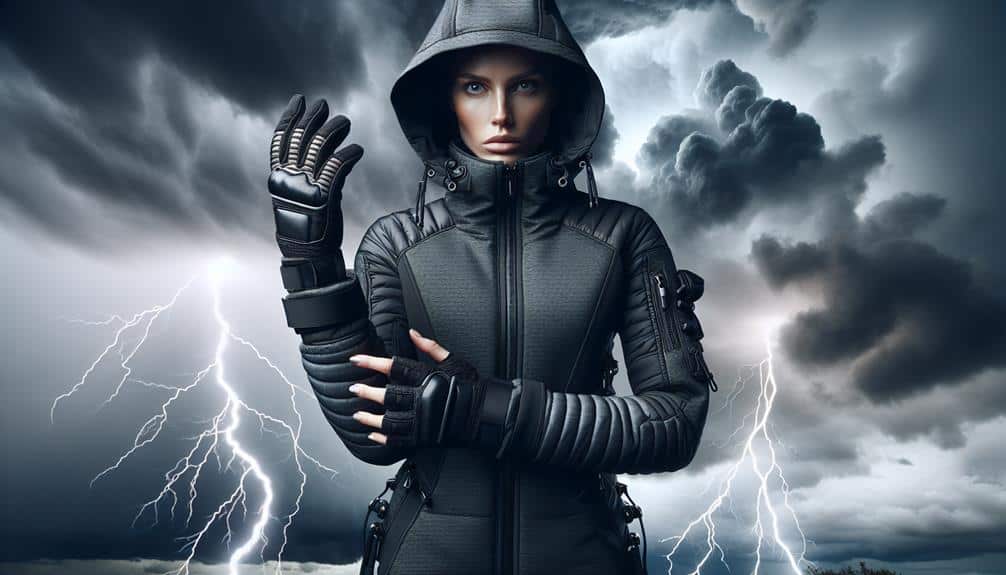
How does high-tech insulated gear revolutionize storm chasing?
By integrating electric heated technology, our gear keeps us warm even in the harshest conditions. As the climate changes, we face increasingly severe weather. High-tech gear not only enhances our safety but gives us the freedom to chase storms regardless of the elements.
Electric heated technology is a game-changer. It provides consistent warmth, eliminating the unpredictability of traditional insulation. With smart controls, we can adjust the heat levels to match the fluctuating temperatures we encounter. This adaptability guarantees that we stay comfortable and focused on our primary objective—capturing the perfect storm footage.
Let's consider the benefits:
- Efficiency: Electric heated gear quickly warms up, reducing downtime and enhancing our operational efficiency.
- Adaptability: Smart controls allow us to customize our warmth, adjusting to changing weather conditions in real time.
Climate change implications mean that storms are more unpredictable and intense. High-tech insulated gear guarantees we're prepared for these challenges. By investing in the latest technology, we not only enhance our safety but also maximize our freedom to explore and document nature's fiercest phenomena.
Frequently Asked Questions
How Do I Properly Store My Insulated Gear After Use?
After use, we should guarantee proper cleaning of our insulated gear to maintain its effectiveness. For storage tips, let's keep it in a cool, dry place, avoiding compression to preserve insulation. Freedom relies on preparedness.
What Maintenance Is Required to Keep Insulated Gear Effective?
To keep our insulated gear effective, we should focus on regular cleaning and proper storage. Regular cleaning removes dirt and oils that degrade insulation, while proper storage prevents damage and maintains the gear's integrity for future use.
Can I Use Insulated Gear in Non-Storm Conditions?
Absolutely, insulated gear isn't just a one-trick pony. We can use it for various outdoor activities by employing layering techniques. It keeps us warm, adaptable, and ready for any adventure, regardless of the weather.
Are There Specific Brands Recommended for Storm Chasing?
When considering the best brands for storm chasing, we recommend Patagonia, North Face, and Columbia. We've done a price comparison, and while Patagonia is pricier, it offers superior quality and durability, making it worth the investment.
How Do I Choose the Right Size for Insulated Gear?
When considering size selection, we should prioritize fitting that allows for comfortable movement. Layering is essential; choose a size accommodating extra layers for varying temperatures without restricting freedom of motion. Always refer to brand-specific sizing charts.
